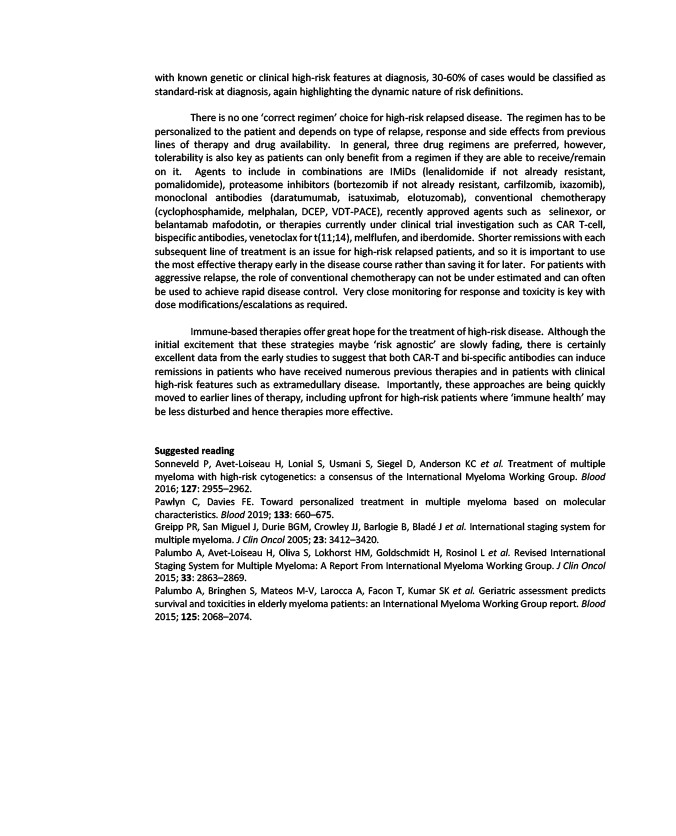
with known genetic or clinical high-risk features at diagnosis, 30-60% of cases would be classified as
standard-risk at diagnosis, again highlighting the dynamic nature of risk definitions.
There is no one ‘correct regimen’ choice for high-risk relapsed disease. The regimen has to be
personalized to the patient and depends on type of relapse, response and side effects from previous
lines of therapy and drug availability. In general, three drug regimens are preferred, however,
tolerability is also key as patients can only benefit from a regimen if they are able to receive/remain
on it. Agents to include in combinations are IMiDs (lenalidomide if not already resistant,
pomalidomide), proteasome inhibitors (bortezomib if not already resistant, carfilzomib, ixazomib),
monoclonal antibodies (daratumumab, isatuximab, elotuzomab), conventional chemotherapy
(cyclophosphamide, melphalan, DCEP, VDT-PACE), recently approved agents such as selinexor, or
belantamab mafodotin, or therapies currently under clinical trial investigation such as CAR T-cell,
bispecific antibodies, venetoclax for t(11;14), melflufen, and iberdomide. Shorter remissions with each
subsequent line of treatment is an issue for high-risk relapsed patients, and so it is important to use
the most effective therapy early in the disease course rather than saving it for later. For patients with
aggressive relapse, the role of conventional chemotherapy can not be under estimated and can often
be used to achieve rapid disease control. Very close monitoring for response and toxicity is key with
dose modifications/escalations as required.
Immune-based therapies offer great hope for the treatment of high-risk disease. Although the
initial excitement that these strategies maybe ‘risk agnostic’ are slowly fading, there is certainly
excellent data from the early studies to suggest that both CAR-T and bi-specific antibodies can induce
remissions in patients who have received numerous previous therapies and in patients with clinical
high-risk features such as extramedullary disease. Importantly, these approaches are being quickly
moved to earlier lines of therapy, including upfront for high-risk patients where ‘immune health’ may
be less disturbed and hence therapies more effective.
Suggested reading
Sonneveld P, Avet-Loiseau H, Lonial S, Usmani S, Siegel D, Anderson KC et al. Treatment of multiple
myeloma with high-risk cytogenetics: a consensus of the International Myeloma Working Group. Blood
2016; 127: 2955–2962.
Pawlyn C, Davies FE. Toward personalized treatment in multiple myeloma based on molecular
characteristics. Blood 2019; 133: 660–675.
Greipp PR, San Miguel J, Durie BGM, Crowley JJ, Barlogie B, Bladé J et al. International staging system for
multiple myeloma. J Clin Oncol 2005; 23: 3412–3420.
Palumbo A, Avet-Loiseau H, Oliva S, Lokhorst HM, Goldschmidt H, Rosinol L et al. Revised International
Staging System for Multiple Myeloma: A Report From International Myeloma Working Group. J Clin Oncol
2015; 33: 2863–2869.
Palumbo A, Bringhen S, Mateos M-V, Larocca A, Facon T, Kumar SK et al. Geriatric assessment predicts
survival and toxicities in elderly myeloma patients: an International Myeloma Working Group report. Blood
2015; 125: 2068–2074.